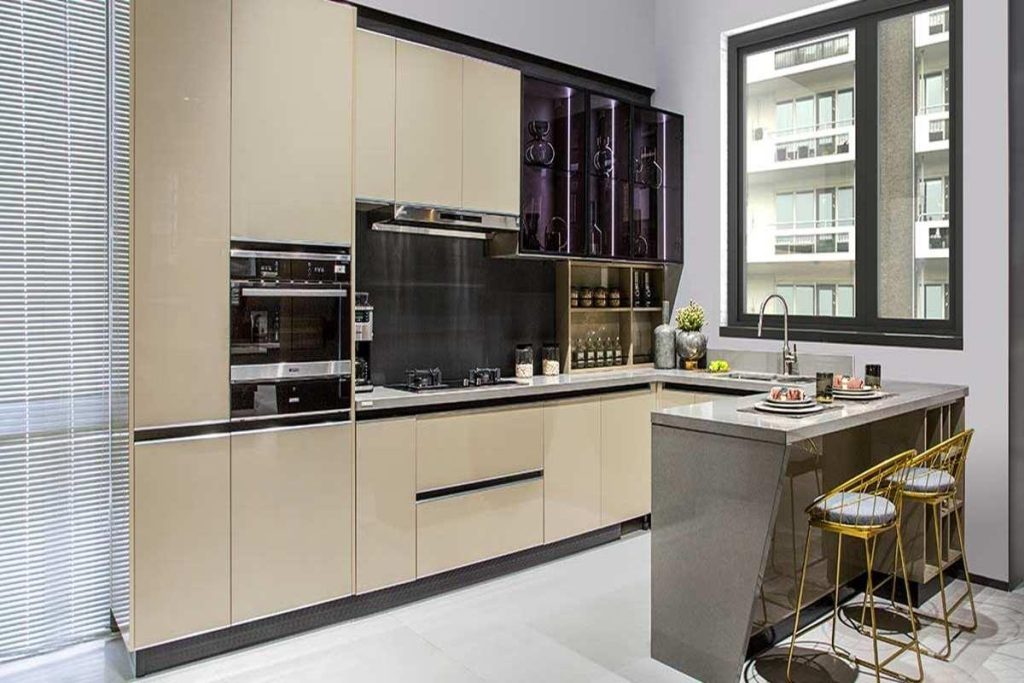We’ve all been there – staring at those kitchen cabinets that have faithfully served for years, wondering if it’s finally time to say goodbye. As someone who’s spent over a decade transforming kitchens, I’ve developed a sort of sixth sense for cabinet lifespans. Your cabinets might not speak, but trust me, they’re definitely communicating when they’re ready for retirement.
1. The Structural Integrity Is Failing
Cabinets should stand strong and steady, not wobble like a newborn fawn. When you notice shelves sagging under the weight of your everyday dishes or doors that hang at awkward angles despite repeated adjustments, your cabinets are waving white flags.
Water damage represents the most common structural killer I encounter. Those innocent-looking swollen areas or bubbling veneer? That’s moisture that has penetrated deep into the material, weakening it from within. Once water breaches the protective outer layer, it’s usually just a matter of time before the entire structure compromises.
I walked into a client’s home last year where the sink cabinet had become so water-damaged that it actually crumbled when I applied gentle pressure to examine it. “But it only started looking bad a few weeks ago,” she insisted. What often surprises people is how long this damage hides before becoming visually obvious.
2. Your Cabinets Have Become Odor Traps
Kitchens naturally accumulate smells – it’s where we cook, after all. But when those cabinets start holding onto odors like treasured memories, something’s wrong. Open a cabinet door and take a deep whiff. Detect mustiness, mildew, or that indefinable “old” smell? That’s not normal, regardless of cabinet age.
These persistent odors typically indicate that moisture has penetrated the cabinet material, creating an environment where mold and mildew thrive in the dark, enclosed spaces. And once these unwelcome guests move in, they’re nearly impossible to evict without replacing the affected materials.
What’s worse? These odors can transfer to your dishes, linens, and even influence the flavor of unsealed foods stored in these spaces. Yikes.
3. They’re Fighting Your Modern Lifestyle
Kitchen designs from even 15 years ago didn’t anticipate today’s appliances or cooking habits. Cabinets that constantly frustrate you with their layout aren’t just annoying – they’re actively working against your kitchen efficiency.
Do you find yourself:
- Storing your stand mixer in the living room because there’s no counter space?
- Playing a daily game of Tetris trying to fit pots and pans into awkward spaces?
- Crouching down to dig through deep corner cabinets for rarely-used items?
- Wishing for more drawers instead of shelves?
If you nodded along to any of these, your cabinets are from another era. Modern cabinet designs include features like deep drawers for pots and pans, specialized storage for cooking sheets, and clever corner solutions that make every inch accessible.
Come to think of it, I’ve never had a client regret updating to more functional storage. Not once.
4. The Hardware Is Failing Consistently
Quality hinges and drawer slides should last decades with proper use. But when drawers start sticking, sliding unevenly, or falling off their tracks despite repeated repairs, it signals a systemic failure.
The tricky part? Sometimes replacing hardware seems like an easy fix, but it rarely solves deeper issues. I’ve seen homeowners replace hardware three times in as many years, spending nearly what new cabinets would cost, because they didn’t address the deteriorating cabinet boxes themselves.
But how do you know when it’s the hardware versus the cabinets? Generally, when more than 30% of your hardware needs replacement within a short timeframe, it’s time to consider full cabinet replacement. The hardware is telling you something – listen to it!
5. Severe Surface Damage Has Taken Its Toll
Cabinets take a beating in the kitchen battlefield. A few scuffs and minor scratches are normal wear and tear, but extensive damage signals deeper problems:
- Delaminating surfaces (where the veneer peels away)
- Deep scratches that expose the substrate material
- Burns or heat damage that has changed the material structure
- Multiple layers of paint applied over decades
- Gouges or dents that collect grime and are impossible to clean
While refinishing works for solid wood cabinets in decent condition, it’s rarely cost-effective for laminate or engineered wood products. In those cases, you’re often throwing good money after bad.
6. Your Kitchen Feels Perpetually Cluttered
Interestingly, what many homeowners attribute to “not enough space” is actually poorly designed storage. Modern cabinetry from companies like OPPEIN has revolutionized how we think about kitchen storage, integrating innovative solutions that can increase functional storage by up to 30% within the same footprint.
When evaluating your cabinets, ask yourself: Is your countertop constantly cluttered because there’s nowhere to put things away? Do you store kitchen items in other rooms due to lack of cabinet space? Are there awkward gaps or wasted areas in your current layout?
If so, your cabinets aren’t maximizing your kitchen’s potential. And in today’s homes where the kitchen serves as a cooking space, homework central, home office, and entertaining hub, that inefficiency affects your entire lifestyle.
7. They’re Dragging Down Your Home’s Value
Let’s be honest – dating your home by decade is easy when the kitchen still sports oak cabinets with cathedral arches or white laminate with visible seams. While some vintage looks cycle back into popularity, most outdated cabinetry actively detracts from your home’s market value.
I recently toured a lovely home with 1980s oak cabinets that the owners had meticulously maintained. Despite their perfect condition, these cabinets instantly made the home feel 40 years old. And though the owners couldn’t see past the quality construction, potential buyers couldn’t see past the dated style.
Want perspective? Visit a kitchen cabinet showroom to see current styles. You’ll immediately recognize the contrast between contemporary designs and what’s hanging in your kitchen. This in-person experience provides context that online browsing simply can’t match.
Making the Decision
The choice to replace cabinets shouldn’t be taken lightly – it’s a significant investment. But continuing to live with failing cabinetry often costs more in daily frustration than we calculate.
And here’s my honest take: I’ve guided hundreds of homeowners through kitchen renovations, and not once has someone told me they replaced their cabinets too soon. The regret always flows in the other direction – wishing they hadn’t waited so long to enjoy a functional, beautiful kitchen.
Your kitchen cabinets serve you daily. When they stop doing their job effectively, perhaps it’s time you relieved them of duty and brought in reinforcements better suited to your current life. After all, we don’t expect our phones to last 30 years – why should we demand that from our cabinets?
[IMAGE_PLACEHOLDER_1][IMAGE_PLACEHOLDER_2][IMAGE_PLACEHOLDER_3]



